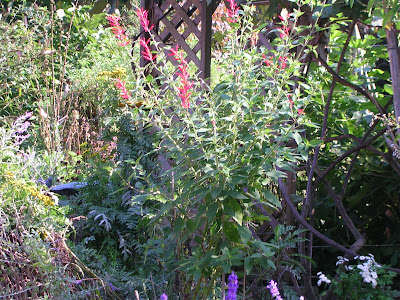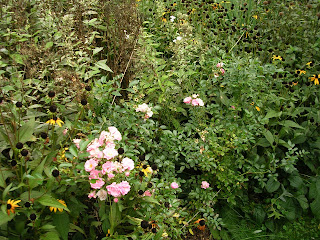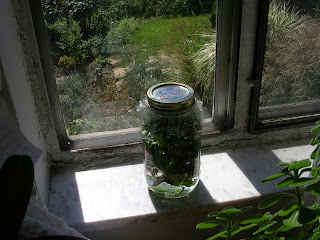
When someone initially gets interested in herbalism they often have no idea that they will eventually need to understand the basic chemistry of herbs. But most of us will need to dive into this arena. For some it may be about understanding the science of herbs and for others it can be a necessary step to making potent plant medicine.
For those people interested in the western bio-medicine approach to herbalism, understanding plant constituents gives insights into how herbs work. For example, turmeric is high in curcumin which has been studied extensively and found to have a wide range of benefits or medicinal actions. Therefore turmeric is considered to be therapeutic because of it's plant constituents. (In contrast, or complement, to traditional herbalism which tends to look at herbal actions and energetics to determine use.)
This article is focused on basic understandings of plant chemistry for the purpose of making potent plant medicines. Or why extracting poplar buds in 20% alcohol is not a great idea or why extracting marshmallow root with 95% alcohol probably won't work out well.
The following is a very basic list of constituents and the mediums they are soluble in to help beginning herbalists making plant medicines.
To delve into the chemistry behind plant constituents please refer to the reading list at the end of the article.
Common Chemical Compounds
Alkaloids
Soluble: alcohol, water, vinegar
Alkaloids posess a huge variety of effects ranging from benign to extremely poisonous. They are extracted extremely well by alcohol and much less so by water (Cech). Plants high in alkaloids are goldenseal, lobelia, and motherwort. Alkaloids can be sometimes dissipated with heat or tannins, or magnified with vinegar (Cech).
Glycosides
Soluble in: water, alcohol
A glycoside is chemically described as a compound that contains a sugar as part of the molecule. There are several different types of glycosides with a variety of effects including beneficial and toxic effects on the heart (cardiac glycosides found in Digitalis and Hawthorn), laxatives (anthraquinone glycosides found in senna, rhubarb), and antiseptic qualities (arbutin found in Uva ursi). Stevia, rebaudiana bertoni, another glycoside, has 40-300 times the sweetness of sucrose.
SaponinsSoluble in: water, alcohol
Saponins are a special type of glycoside. We use saponins (hopefully) daily in our soaps. Saponins break up fat molecules (think of the Dawn commercials and the big piles of dirty dishes). They also have a variety of other effects including adaptogenic, diuretic, anti-spasmodic, and expectorant (Cech). Horse chestnut, licorice, and chickweed all have saponins.
Flavonoids
Soluble in: water, alcohol
Flavonoids are another type of glycoside. Among the important effects of flavonoids is their antioxidant effect. An antioxidant is a molecule capable of slowing or preventing the oxidation of other molecules. They are also known to decrease capillary fragility.
Tannins
Soluble: glycerin, water, alcohol
Oak, tea, witch hazel, and red clover all contain tannins. Herbs with high tannin content are generally used as an antiseptic, a styptic, and to shrink tissues. Tannins are rendered inactive with the presence of milk and may have the ability to render some alkaloids inactive (Kress, Cech).
Mucilage
Soluble: Water (Cold preferred)
Soothing to the gut and urinary system, herbs high in mucilage also tend to be nutritive and nourishing to the immune system (Cech). Herbs with high mucilage content include marshmallow, mullein, comfrey, and slippery elm.
Polysaccharides
Soluble: water
Generally immune stimulating and nutritive, herbs high in polysaccharides are burdock, astragalus, and boneset (Cech).
Minerals, trace elements
Soluble: water, vinegar
Vitamins
Soluble: water,
Vitamins A, D, E, and K are fat-soluble, with the rest being water soluble.
Resins
Soluble: alcohol, oil
Resins are typically expectorant and bitter. Herbs containing high amounts of resins include cottonwood buds, calendula, and gumweed.
Solvents
Water
Water extracts almost everything with the exception of resins. Different temperatures may effect the extraction (simmering for barks and roots, just boiled for leaves, cold for mucilaginous plants). Some herbalists prefer to use distilled water.
 |
| Marshmallow cold water infusion |
Alcohol
Almost everything is extracted by alcohol with the exception of minerals and trace elements. The percentage of alcohol used in plant medicine can be determined by it's plant constituents. For example, resins must be extracted in 95% alcohol (cottonwood buds, propolis and myrrh are good examples). Other alcohol percentages for certain plants are based on scientific queries into constituents or personal preference. Richo Cech has a nice listing in his book, Making Plant Medicine.
Mucilage is extracted by alcohol and then broken down by it, so it's best to use a cold water infusion and then add just enough alcohol if wanting to preserve it.
Proof vs. percentage
In the above photo you can see it listed as 100 proof. The alcohol percentage is half of the proof. So in this case the above vodka is 50% alcohol.
Everclear (which is only available in certain states) is 95% alcohol - the highest percentage possible. (Note that some states carry everclear at 151 proof only, be sure to check.)
Many vodkas, brandy's and other liquors are 40% alcohol. In general it is best to choose a pure alcohol, not one that is flavored (with who knows what!).
Glycerin
Glycerin is a sweet substance made from plant or animal sources and is chemically related to alcohol. It's made by the breaking down of fat and oils with the use of high pressure steam (Cech). Herbalists use glycerin to extract medicinal properties from plants when wanting to avoid alcohol.
Glycerin does poorly at extracting properties with dried plant material so fresh plants are highly recommended. According to Henriette Kress, some minerals and trace elements, some alkaloids, some acids, and some mucilage are extractable with glycerite. Richo Cech reports that tannins are extracted very well by glycerin.
 |
| Glycerin being added to a willow bark tincture to further extract tannins. |
Oil
Oils have the ability to extract oils and resins.
 |
| Calendula flowers extracted into olive oil. |
Vinegar
Vinegar has the ability to extract minerals, trace elements, and alkaloids. Most herbalists use apple cider vinegar, balsalmic vinegar, or other high quality vinegars. (Distilled white vinegar is not reccomended for internal use.)
Besides extracting a variety of constituents, vinegar can also add other benefits to the end product as well. It is considered specific for digestion and the respiratory system.
 |
| Chickweed being extracted with vinegar. |
Further Reading
The best resource on herbal chemistry is Lisa Ganora's book:
 The nurseries around my house do not offer this particular basil variety. I had to go to Ohio to find it. So if you are fortunate enough to live near a good nursery that carries a variety of herbs, you may be able to get 'Minette'. It is better than even 'Spicy Globe'. It keeps its shape and is very prolific! Here is the 'Minette' early on in the garden. It's the fourth plant from the left. The little round mound.
The nurseries around my house do not offer this particular basil variety. I had to go to Ohio to find it. So if you are fortunate enough to live near a good nursery that carries a variety of herbs, you may be able to get 'Minette'. It is better than even 'Spicy Globe'. It keeps its shape and is very prolific! Here is the 'Minette' early on in the garden. It's the fourth plant from the left. The little round mound.






























 Most herbies use vodka, but not all. Brandy is used, whiskey, and sometimes whatever is in the house. I've been known to grab gin or rum if the herb was ready and that was all that was available. It is more about the alcohol, and the ability to preserve. If grain alcohol is used (not available in my state), add some water to the mix because most herbs need some water in order to extract well. Half and half is a good blend. Personally I use the cheap vodka because chances are I will go through a couple of gallons in the fall. This doesn't mean that I'll actually use all of that tinctured vodka over the winter, but I will have lots to share with my family and friends as the cold and flu season goes on. Elderberry - I make at least a quart! Holy Basil - that's another quart or more. And then there is Echinacea, Chamomile, Passion Flower, and Vitex. I could go on and on - but you get my drift.
Most herbies use vodka, but not all. Brandy is used, whiskey, and sometimes whatever is in the house. I've been known to grab gin or rum if the herb was ready and that was all that was available. It is more about the alcohol, and the ability to preserve. If grain alcohol is used (not available in my state), add some water to the mix because most herbs need some water in order to extract well. Half and half is a good blend. Personally I use the cheap vodka because chances are I will go through a couple of gallons in the fall. This doesn't mean that I'll actually use all of that tinctured vodka over the winter, but I will have lots to share with my family and friends as the cold and flu season goes on. Elderberry - I make at least a quart! Holy Basil - that's another quart or more. And then there is Echinacea, Chamomile, Passion Flower, and Vitex. I could go on and on - but you get my drift.  There are varying opinions on how long to allow tinctures to sit. Some people tell you to shake it daily, as well. So, I'll tell you my method, and you can come up with your own.
There are varying opinions on how long to allow tinctures to sit. Some people tell you to shake it daily, as well. So, I'll tell you my method, and you can come up with your own.


 Sterilize a quart jar for 10 minutes with boiling water, then add your herbs and white wine vinegar or red wine vinegar. I would not use white distilled vinegar. Only use that kind of vinegar for cleaning. I also would not use apple cider vinegar either.
Sterilize a quart jar for 10 minutes with boiling water, then add your herbs and white wine vinegar or red wine vinegar. I would not use white distilled vinegar. Only use that kind of vinegar for cleaning. I also would not use apple cider vinegar either.

 But lower, closer to the ground we found some glossy leaves that bugged me. They looked like something familiar... that way that plants I've studied in field guides over the years do, when they've never actually turned up during any outtings. In other words, those I've yet to find.
But lower, closer to the ground we found some glossy leaves that bugged me. They looked like something familiar... that way that plants I've studied in field guides over the years do, when they've never actually turned up during any outtings. In other words, those I've yet to find. I reached down and crushed a leaf to sniff...Wintergreen! Ah!!! A Bazillion plants scattered over a few acres! And me without my camera. The berries taste just like wintergreen candy, but not quite as sweet. We dug a few plants, and I brought them home with the intent of getting a patch going here. I wish that I'd picked a lot of the leaves and saved them for tea, but it's not that far to return...
I reached down and crushed a leaf to sniff...Wintergreen! Ah!!! A Bazillion plants scattered over a few acres! And me without my camera. The berries taste just like wintergreen candy, but not quite as sweet. We dug a few plants, and I brought them home with the intent of getting a patch going here. I wish that I'd picked a lot of the leaves and saved them for tea, but it's not that far to return... As I pinched, the whole thing came up, and the roots are underground runners that were buried lightly under decayed leaves. I hope it survives, as it will be planted out first thing in the morning.
As I pinched, the whole thing came up, and the roots are underground runners that were buried lightly under decayed leaves. I hope it survives, as it will be planted out first thing in the morning. They moved on to the Big Apple within a couple of years, but our friendship endured and they even hosted us during many trips to the wholesale shows while we had a shop to stock. In fact, we started attending shows like "the boutique show" at Javitz just so we could spend a weekend AND buy some cool clothes for the shop.
They moved on to the Big Apple within a couple of years, but our friendship endured and they even hosted us during many trips to the wholesale shows while we had a shop to stock. In fact, we started attending shows like "the boutique show" at Javitz just so we could spend a weekend AND buy some cool clothes for the shop. so it was a great surprise to hear that Robbie would be spending a week in a nearby town on business, and Laura would be able to zip over here during the day while she spent some time with him.
so it was a great surprise to hear that Robbie would be spending a week in a nearby town on business, and Laura would be able to zip over here during the day while she spent some time with him. We had a great time. First some hugs, then (of course) down into the woods.
We had a great time. First some hugs, then (of course) down into the woods. Later we went in to downtown Mount Joy for a bite to eat. Molly couldn't get off school that day because of a field trip, but fortunately she got back in time for a hug.
Later we went in to downtown Mount Joy for a bite to eat. Molly couldn't get off school that day because of a field trip, but fortunately she got back in time for a hug. I must apologize to Toby Myers, proprietor of The Tilted Kilt. It's been over a week since we've been there and I can't remember what everyone ate.
I must apologize to Toby Myers, proprietor of The Tilted Kilt. It's been over a week since we've been there and I can't remember what everyone ate.  All I can say is that we ALL enjoyed the meal thoroughly and the dessert that we shared was delicious!
All I can say is that we ALL enjoyed the meal thoroughly and the dessert that we shared was delicious! 